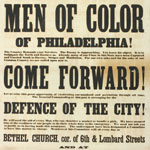 |
Men of Color of Philadelphia! (Philadelphia, 1863).
In the face of the impending Confederate invasion of Pennsylvania in June of 1863, the young African American educator and activist Octavius Catto worked to organize a black regiment for defense of the state. When they arrived in Harrisburg they were turned back. State authorities were not yet ready or willing to accept black soldiers. This rallying cry is signed by forty-five Philadelphia African American leaders – clergymen, educators, businessmen – joined by Frederick Douglass, touring the north encouraging African American enlistment.
|
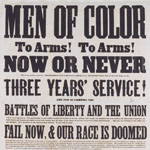 |
Men of Color! To Arms! To Arms! (Philadelphia, 1863).
On June 22nd the Adjutant-General of the Army authorized the recruitment of “three Regiments of Infantry, to be composed of colored men.” On July 6 a mass meeting of African Americans ratified the text of this dramatic broadside, printed on three joined sheets. Frederick Douglass, still busy in town, joined fifty-three local leaders in signing the call to arms. |
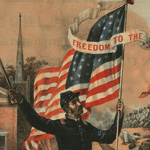
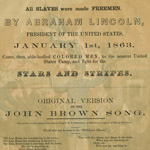
|
Supervisory Committee for Recruiting Colored Regiments, Freedom to the Slave. Colored lithograph. (Philadelphia, 1863 or 1864).
The reverse of this dramatic illustration is a recruiting poster. From its reference to emancipation, and the phrase urging “colored men” to come “to the nearest United States Camp,” (rather than any specific camp) suggests this handbill may have been circulated by Union troops in the South |
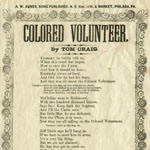 |
Tom Craig, Colored Volunteer (Philadelphia, 1863).
This is one of several song sheets McAllister collected celebrating the valor of the colored volunteers.
|
 |
Addresses of the Hon. W. D. Kelley, Miss Anna E. Dickinson, and Mr. Frederick Douglass, at a Mass Meeting, held at National Hall, Philadelphia, July 6, 1863, for The Promotion Of Colored Enlistments (Philadelphia, 1863).
Abolitionist Congressman William D. Kelley and fiery orator Anna E. Dickinson join Frederick Douglass and African American community leaders in this spirited rally to encourage African American enlistment |
 |
Nick Biddle. Albumen print carte-de-visite (1864).
Nick Biddle of Pottsville was a long-time member of the local militia. His unit was mobilized into the First Defenders and sent to Washington to guard the capital. On April 18, while marching through Baltimore, his unit was attacked by a mob throwing rocks and bricks, and Biddle suffered a severe head wound. This photograph of the elderly Biddle was sold at the Great Central Fair in June, 1864. |
 |
Supervisory Committee for Recruiting Colored Regiments, No Person Is Wanted as an Officer in a Colored Regiment who “feels that he is making a sacrifice in accepting a position in a Colored Regiment” . . . . (Philadelphia, 1863).
The Supervisory Committee for Recruiting Colored Regiments, largely the creation of the Union League, coordinated African American enlistments and raised funds for the colored regiments. Their anti-racist attitude is evident in this admonition to would-be white officers. |
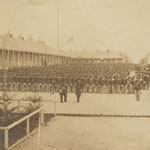 |
24th Regiment. U.S.C.T. [i.e., United States Colored Troops] at Camp Wm: Penn. Albumen print photograph(Philadelphia, 1863). |
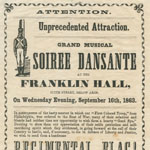 |
Attention. Unprecedented Attraction. Grand Musical Soiree Dansante at the Franklin Hall (Philadelphia, 1863).
Mary L. Brown and her association of African American ladies sponsored this evening of music and dancing to raise funds for a regimental flag for the First Colored Troop recently sent into combat. Music was provided by Joseph Anderson, successor to Philadelphia’s famous African American band leader and composer Francis Johnson. |
 |
United States Army, Adjutant General’s Office Washington, June 22d, 1863, Sir: I am instructed by the Secretary of War to inform you that you are hereby authorized . . . to raise in Philadelphia, or the eastern part of Pennsylvania, three Regiments of Infantry, to be composed of colored men . . . (Washington, 1863). |
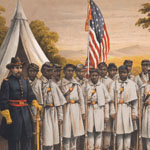 |
P. S. Duval & Sons. United States Soldiers at Camp William Penn. Chromolithograph(Philadelphia, 1864).
Local African American regiments trained at Camp William Penn, in Cheltenham Township, just north of the city. Shown here are men of Company G of the 25th Regiment United States Colored Troops, one of a dozen African American regiments that trained here. |
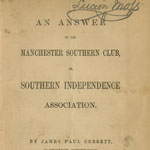 |
James Paul Cobbett, An Answer to the Manchester Southern Club, or Southern Independence Association (Manchester, 1863). |
 |
Corrected galley proofs for An Answer to the Manchester Southern Club.
With emancipation established as a war goal, British abolitionists mobilized to check the movement by textile manufacturers to recognize the Confederacy. This rare pamphlet is part of that agitation, one of only three known surviving copies, and the only one in the United States. It was given to us in 1864. We don’t know how McAllister acquired the corrected galley proofs for this rarity. |
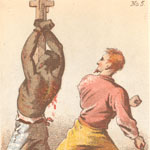 |
Henry Louis Stephens, Story of a Slave. Chromolithographed cards (Philadelphia, 1863).
These twelve collecting cards illustrate the story of a slave, from the plantation, to his escape, enlistment in the Union Army, and death on the battlefield. They are among the many illustrated works by Philadelphia artist Henry Louis Stephens. Other examples of his work are also displayed. |
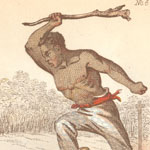 |
|
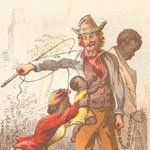 |
|
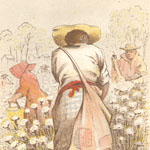 |
|
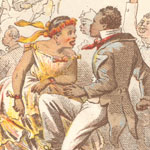 |
|
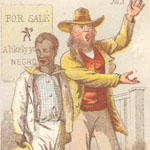 |
|
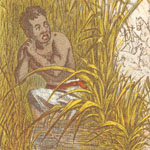 |
|
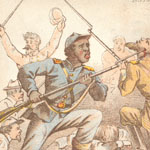 |
|
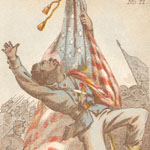 |
|
 |
|
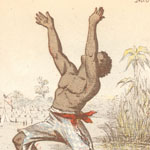 |
|
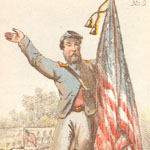 |
|

























